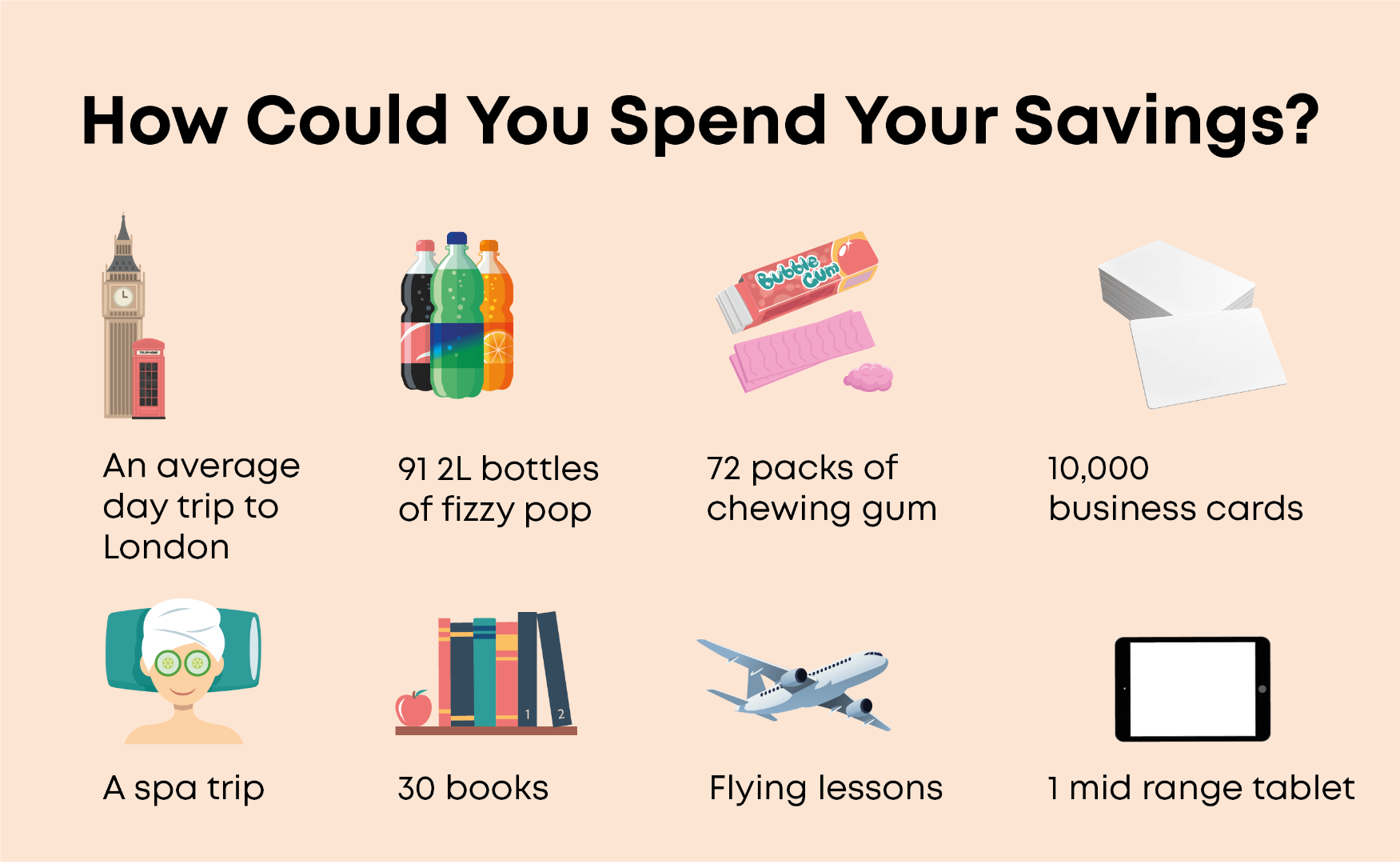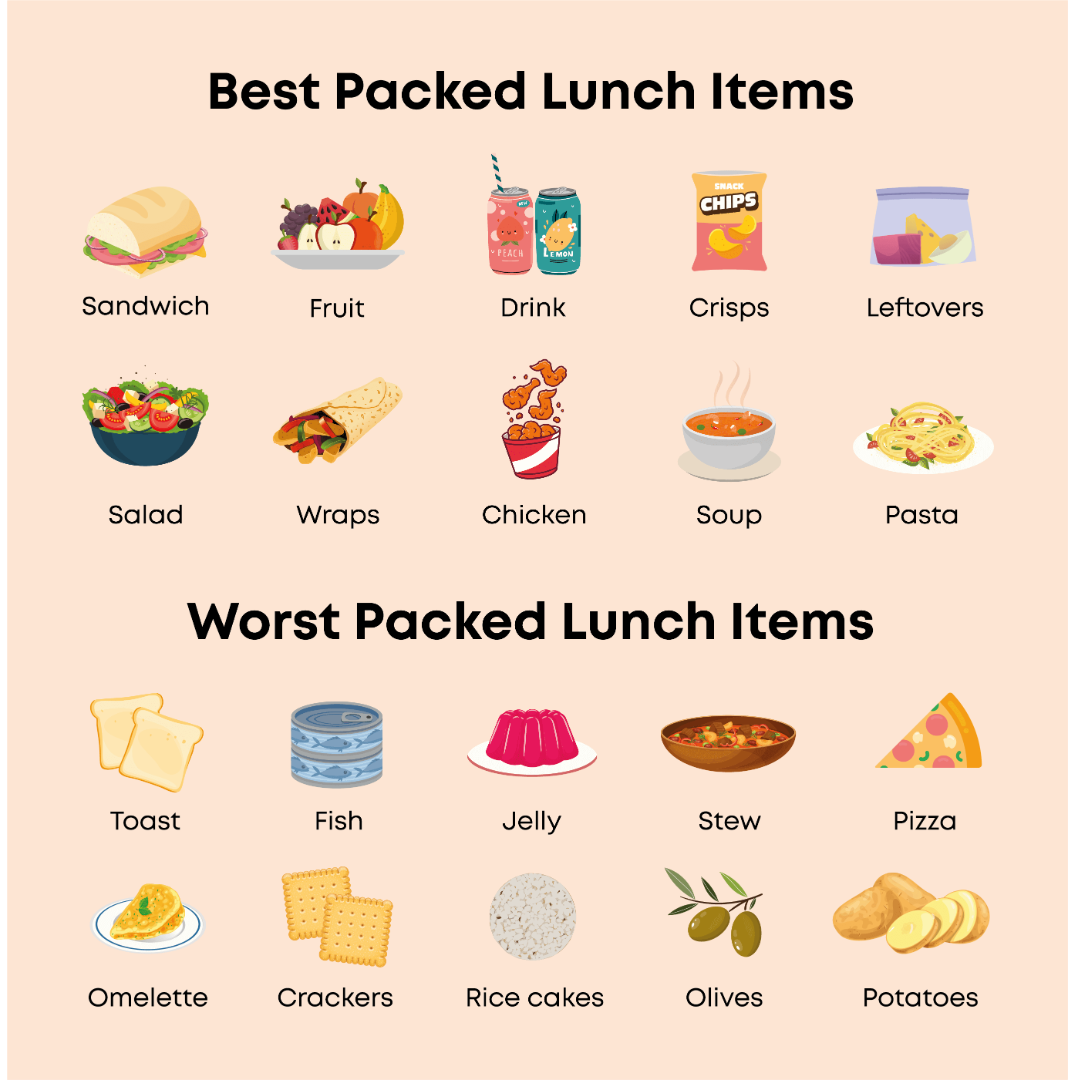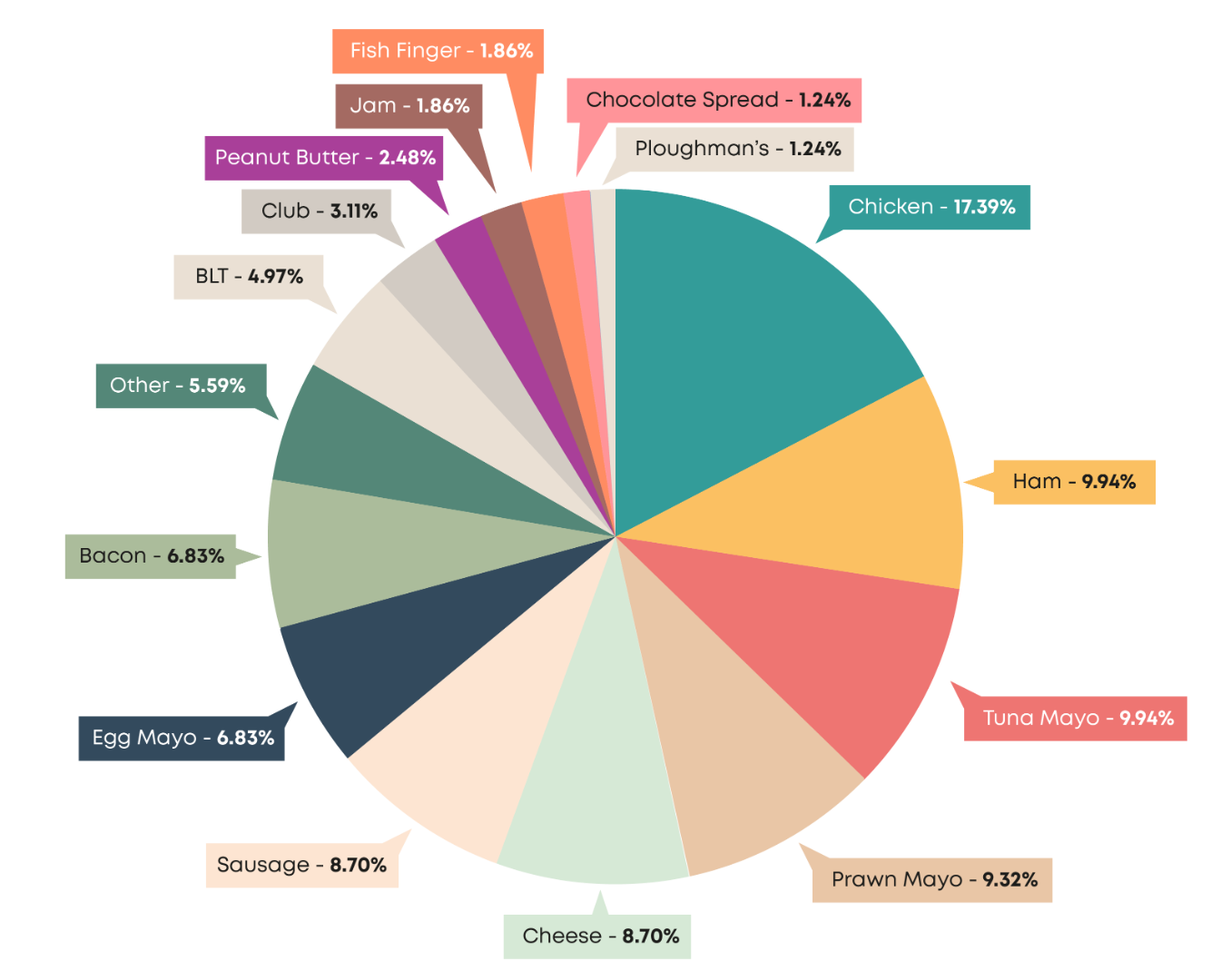At the start of each year, thousands of us set goals to spend less and eat better – and taking homemade lunches to work might be high on your agenda to help with both of these goals.
To uncover how many people are packing up their lunch to save pounds (of weight and money!), we quizzed over 1,000 UK office workers on their lunchtime spending and eating habits. Plus, we asked Anglia Ruskin University’s very own Dr Suzanna Forwood, a Food Psychologist at Anglia Ruskin University specialising in food choice, what your choice of packed lunch says about you.
What’s your new year’s resolution?
Taking homemade lunches to work features in the top 5 of 2023’s new year’s resolutions, along with eating better, getting fitter, saving money and losing weight – see an emerging theme?
- Eat better – 48%
- Get fitter – 46%
- Save money – 44%
- Lose weight – 39%
- Make more homemade lunches – 32%
Almost 1 in 3 (32%) of us have set a goal to bring in more homemade lunches this year – which can give us more control over what we’re putting in our bodies and, in turn, allow us to achieve our health goals too.
But how much healthier is a homemade lunch for your wallet as well as your waistline?
Pack up plenty of savings!
With January in full swing, your new years resolutions may already be waning. But what could staying on track be worth in the long run?
According to our survey, the average person spends £21 a week on their work lunches – that’s £1,092 a year!
1 in 4 (24%) of us buy a meal deal or lunch from a shop or café at least once a week, with 18% of us doing this multiple times per week.
But what about the big spenders? 2% of respondents admitted to buying lunch out every day.
If you’re currently buying a £3.50 meal deal once a week, this would cost you somewhere in the region of £182 a year. But what else could you be spending that dosh on?
For almost £200, you could afford an average day out in London, a spa weekend, flying lessons, 30 paperback books, 72 packs of chewing gum, 91 2 litre bottles of fizzy pop, or a whopping 10,000 business cards!

The cost-of-living crisis has made a dent in our lunchtime spending.
The majority of us have cut back on our lunchtime spending - 40% of our respondents shared that they’ve started spending less less since the start of the cost-of-living crisis. That’s in comparison with the 29% who spend the same as before and 30% who admitted to spending more than ever before.
Hey, big spender
In line with the general gender pay gap, our survey found that men are more likely to buy lunch from a shop than women – 51% of men buy lunch from a shop or café at least once a week, compared with just 40% of women.
Age also played a role in our lunch spending habits. 35–44-year-olds spend the most on their lunch, averaging £29 a week, compared with just £4 for 18-24-year-olds.
However, a whopping 75% of 18-24 year olds admitted that they now spend more on their lunches following the start of the cost-of-living crisis. This could correlate with this age group rising through the ranks at work or gaining full time employment following higher education.
45–54-year-olds have cut back the most, with 2 in 5 of this age respondents sharing that they actively spend less.
A quick bite to eat
Healthy meals are notoriously time consuming to make and eat, presenting a bit of a challenge if you’re on a scheduled lunch break at work.
Our survey found that most of us get a 30-minute lunchbreak (48%) so we need something we can eat quickly. 15% of respondents told us they get even less time than that to scoff something down mid-day!
A lucky 27% get an hour for their lunch break so can afford to spend a little longer eating their food and can probably enjoy something warming like leftovers.
TikTok made me buy it
Our results have shown that you can save big bucks by making your own lunches, but the whole point of buying lunch out is for convenience – not having the think what to eat every day. So where are you meant to get your inspiration from?
We asked our survey respondents for their top sources of lunch inspiration, and the following five came top of the list:
- Friends and family – 31%
- Availability of ingredients – 31%
- Social media – 28%
- Recipe websites - 24%
- Discounts in supermarkets - 22%
25–34-year-olds are most likely to be inspired by social media (37.93%), compared with every other age group, who mainly got their inspiration from friends and family.
The rise of ‘FoodTok’ videos on video sharing platform TikTok could very well be linked to this. Whilst in lockdown, cloud bread and whipped coffee were on the top of everyone’s to-make list, but as of January 2023 the hashtags #lunch and #lunchideas have 15.6 billion and 2.6 billion views respectively.
Whether you make Emily Mariko’s famous salmon rice bowl or get some refreshingly health inspo from The Salad Lab, social media is a great place to discover new food trends to add to your lunch box!
However, the rise of impressive and inspirational lunches that we see online can have a negative impact as well.
Nearly 1 in 5 of us (19%) feel judged on the contents of our packed lunch. Women are slightly more likely to feel judged on the contents of their lunch (20% vs 18% of men).
Older generations (55+) don’t feel judged at all, whereas 25-34 year olds feel the most judged (38%) followed by 25% of 18-24 year olds and 45-54 year olds respectively.
It’s important not to hold yourself to the high standards you see online. Many food influencers make and film their lunches as part of their full-time job, so your expectations might be set a little too high if you’re trying to keep up with them!
As long as you’re striving towards a balanced meal that won’t break the bank, that’s a win in our eyes.
What’s in your lunchbox?
If you’re still stuck for ideas, we’ve got you covered. We wanted to know the UK’s favourite and least favourite lunchbox items to help you impress your colleagues and your tastebuds. Here’s what they said!

Sandwiches came out top of the list, followed by fruit and a drink. At the midway point were leftovers from dinner the night before, whereas salad and wraps were also favoured by our survey-takers. All in all, a very healthy list.
On the other hand, the practicalities of toast in the workplace means this crispy treat gains the reputation of worst packed lunch item, followed by fish (no one likes a stinky microwave!), jelly, stew and pizza.
We also quizzed our survey respondents on their favourite sandwich fillings. Chicken was the clear winner with 17% of the vote, followed by ham (10%), tuna mayo (10%), prawn mayo (9%) and cheese (8%).
The least popular sandwich fillings as voted by UK workers include ploughman’s (1%), chocolate spread (1%) and fish fingers (2%).

What does your packed lunch say about you?
Using the information gathered from our survey, we tasked Dr Suzanna Forwood, a Food Psychologist at Anglia Ruskin University who specialises in food choices, on what your choice of packed lunch says about you.
1. Sandwiches & wraps
"This choice is likely to be a mixture of people buying readymade items or making them at home. The two will be very different types of people.
"Those buying sandwiches are out for convenience and work somewhere with access to shops – either on the way to work or at work. The sandwich is the most popular lunch option in the UK from retail outlets and the meal deal is a value option for many of us who have access to shops for lunch. The sandwich itself can be a good option, but the crisps and drink may quickly reduce the nutritional value of this as a meal option. These are people who might struggle for time in the mornings or be willing to pay a bit extra for the convenience of not making their lunch for themselves.
"The other group that takes sandwiches to work are those who are also preparing this for their children’s lunches – it is easier for everyone in the family to have the same option and takes less time to prepare. It is also cost effective to buy large packs to be shared out. These people live with children and take a practical approach to getting everyone fed. They are probably quite organised in the mornings. And they may have an eye on healthiness – there are lots of options to meet a range of food preferences and diets."
2. Leftovers from dinner
"This choice of packed lunch suggests someone who is cooking dinner, probably from scratch, and in more quantities than one meal. They have time in the evenings and resources to do this or motivation and interest in cooking. They may also be aware of food waste or want to enjoy lunch without the work of preparing something separate. Some will plan this when cooking evening meals and chose to cook more, while others will be more opportunistic. Those in a household of one might do this, as it is relatively hard to cook one-person quantities and this strategy can help with the extra food.
"Everyone using home-cooked meals leftovers for packed lunch will likely be getting a better balance of nutrients than the sandwich option – we tend to include more veg and nutritious foods when cooking meals from scratch. Those using ready meal or takeaway leftovers will have a considerably less healthy option. So, it depends a lot on what is in the leftovers!"
3. Salad
"This choice of lunch is very likely to be chosen by those watching their weight, and interested in something fresh. It is probably more popular in the summer, when more options are available in the shops at a more accessible price. But salads can be made all year round – they don’t have to be just ‘rabbit food’! Some salad options can be surprisingly unhealthy – it all depends on what is included, and what sauce or dressing is used. So, while these people might THINK they are eating more healthily, it is not a given. For that reason, this might be the option for colleagues who want to look like they are healthy."
4. Soup
"This option of lunch serves a variety of purposes for different people. Soup is easy to prepare and eat (just drunk from a mug if needs be) so has lots of convenience. It is warming and filling, so can be good for those working outdoors or prone to cold, or those wanting a reassuring warm moment in their day. Some varieties of soup are very traditional and may appeal to those who want a simpler and more predictable option. While other soups are more exotic and unusual, and may appeal to those enjoying a wider range of flavours in their diet.
"For these reasons, I suspect people who choose soup are people who know their own mind, and are not trying to make a point with their lunch. They will have their reason for choosing it, and won’t be swayed by colleagues."
5. Pasta
"As with sandwiches – this category is likely a mixture of those making it at home, or buying it readymade. So, the same two categories of people are also here. But pasta is more of a “proper” meal. It can be hot, and hearty, and include both veg and protein without necessarily including butter, mayo or rich sauces. I suspect pasta eaters have thought about their lunch – they may have explored a range of other types of lunch and not found them to their taste. Maybe they want something more sustaining than soup or salad, but healthier than a shop-bought sandwich. Maybe they lack the time to make meals, so don’t have leftovers, but would like to have a meal for lunch and not a sandwich.
"The final group, not captured by this survey, are those who choose different options each day. Indeed, many of us are probably in this category because we know that repeatedly eating the same or similar foods can reduce the pleasure taken in eating them. Unless we experience food neophobia, a profound dislike of unfamiliar foods, in which case the same foods feel like the only safe options. Humans as omnivores prefer a varied diet, so we may have evolved a preference for variety in our diet. This serves us well as it turns out the best way to a healthy diet is variety."
Will you be bringing more homemade lunches to work this year? Let us know your go-to desk lunch on social media by using #instantprintuk!

 (1).jpg)


.jpg)
